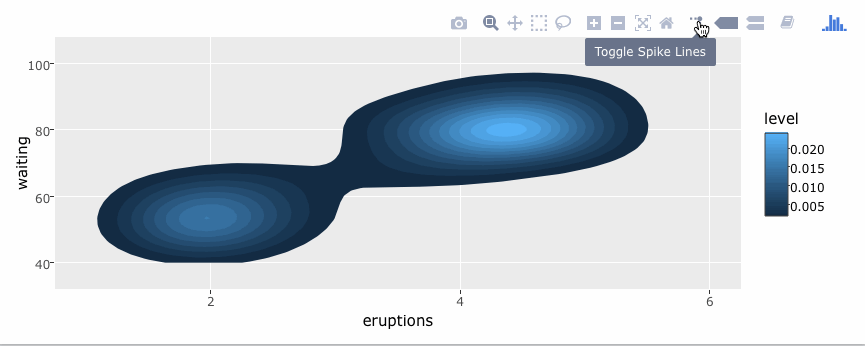

An R package for creating interactive web graphics via the open source JavaScript graphing library plotly.js.
Install from CRAN:
install.packages("plotly")Or install the latest development version (on GitHub) via
{remotes}:
remotes::install_github("plotly/plotly")If you use ggplot2,
ggplotly() converts your static plots to an interactive
web-based version!
library(plotly)
g <- ggplot(faithful, aes(x = eruptions, y = waiting)) +
stat_density_2d(aes(fill = ..level..), geom = "polygon") +
xlim(1, 6) + ylim(40, 100)
ggplotly(g)
By default, ggplotly() tries to replicate the static
ggplot2 version exactly (before any interaction occurs), but sometimes
you need greater control over the interactive behavior. The
ggplotly() function itself has some convenient “high-level”
arguments, such as dynamicTicks, which tells plotly.js to
dynamically recompute axes, when appropriate. The style()
function also comes in handy for modifying the underlying trace
attributes (e.g. hoveron) used
to generate the plot:
gg <- ggplotly(g, dynamicTicks = "y")
style(gg, hoveron = "points", hoverinfo = "x+y+text", hoverlabel = list(bgcolor = "white"))
Moreover, since ggplotly() returns a plotly object, you
can apply essentially any function from the R package on that object.
Some useful ones include layout() (for customizing
the layout), add_traces() (and its higher-level
add_*() siblings, for example add_polygons(),
for adding
new traces/data), subplot() (for combining
multiple plotly objects), and plotly_json() (for
inspecting the underlying JSON sent to plotly.js).
The ggplotly() function will also respect some
“unofficial” ggplot2 aesthetics, namely
text (for customizing
the tooltip), frame (for creating
animations), and ids (for ensuring sensible smooth
transitions).
The plot_ly() function provides a more direct interface
to plotly.js so you can leverage more specialized chart types (e.g., parallel
coordinates or maps) or
even some visualization that the ggplot2 API won’t ever support (e.g.,
surface, mesh, trisurf, etc).
plot_ly(z = ~volcano, type = "surface")
To learn more about special features that the plotly R package
provides (e.g., client-side
linking, shiny
integration, editing and
generating static images, custom events in
JavaScript, and more), see https://plotly-r.com. You may already be familiar with
existing plotly documentation (e.g., https://plotly.com/r/), which is essentially a
language-agnostic how-to guide for learning plotly.js, whereas https://plotly-r.com is
meant to be more wholistic tutorial written by and for the R user. The
package itself ships with a number of demos (list them by running
demo(package = "plotly")) and shiny/rmarkdown examples
(list them by running plotly_example("shiny") or
plotly_example("rmd")). Carson also keeps numerous slide decks with useful examples
and concepts.
Please read through our contributing guidelines. Included are directions for opening issues, asking questions, contributing changes to plotly, and our code of conduct.
